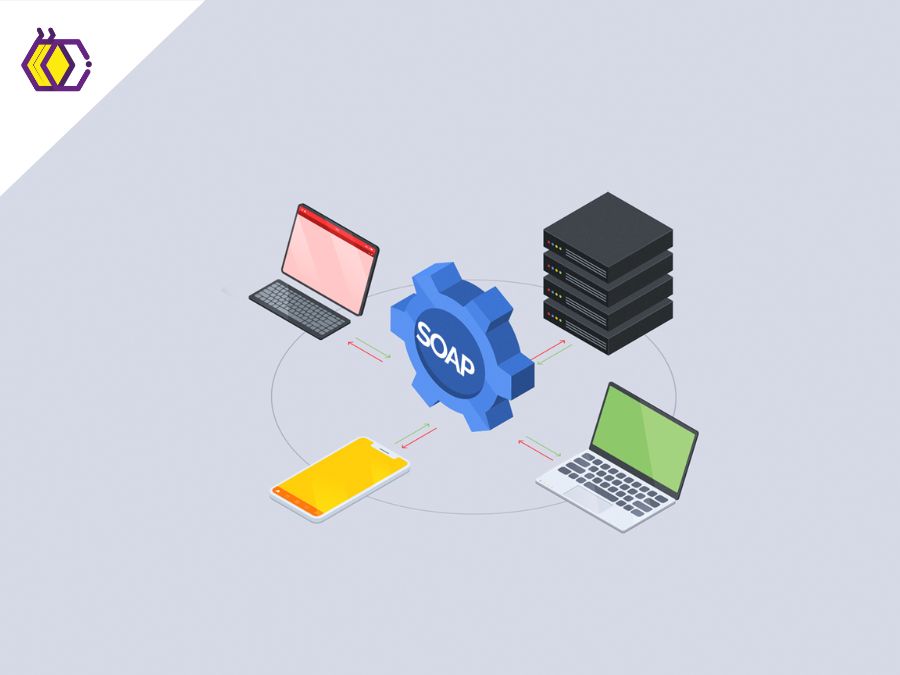

SOAP
(7 minutes of reading) In the era of digital communication, the exchange of information between systems and applications is essential. In this context, specific protocols emerged to facilitate this communication. One of them is the SOAP (Simple Object Access Protocol). In this article, we'll explore in detail what SOAP is, its structure, how it works, and its practical applications. WHAT IS SOAP? SOAP is an XML-based communication protocol designed to allow the exchange of information between distributed systems on the web. The protocol provides a standardized way to structure, send, and receive messages between applications, regardless of their platforms and programming languages. SOAP was developed to overcome interoperability challenges between heterogeneous systems. Before SOAP, communication between applications using different technologies was complex and required custom integration. With SOAP, it is possible to create web services that can be consumed by any application, regardless of the platform or programming language used. SOAP STRUCTURES The structure of SOAP is based on XML messages. Each SOAP message consists of a SOAP envelope that surrounds the message content. The SOAP envelope has a hierarchical structure composed of three main parts: header, body, and fault. Below we detail each of these structures. a) HEADER The header is optional and contains additional information about the message, such as authentication, security, or metadata. It allows relevant information to be transmitted along with the SOAP message. b) BODY The body is mandatory and contains the main data of the message. It can contain custom XML elements that describe the specific information being passed. The body is the central part of the SOAP message and contains the data that will be processed by the receiving application. c) FAULT Fault is optional and is used to report errors or exceptions that occurred during message processing. If a problem occurs during message processing, the SOAP response can contain detailed information about the error, letting the sender know what went wrong. This well-defined structure of SOAP allows applications to understand and process SOAP messages consistently. SOAP OPERATION SOAP operates on a request and response model. An application sends a SOAP message as a request to another application, which processes the request and returns a SOAP message in response. The SOAP request is constructed based on the definition of the web service to be invoked. It includes the required parameters and target web service address information. The SOAP message is then sent over a transport protocol such as HTTP using a POST request. The server receiving the SOAP message processes it and sends a SOAP response back to the sender. The SOAP response can contain the requested data, status information, or even an error message if a problem occurs during processing. SOAP supports several transport protocols, such as HTTP, SMTP and TCP/IP, allowing flexibility in choosing the most suitable protocol for a given application. ADVANTAGES OF SOAP SOAP offers several advantages that make it a popular choice for communicating between distributed systems. Are they: 1) INTEROPERABILITY SOAP was designed to be platform and language independent. This means that applications developed using different technologies can communicate using SOAP, ensuring interoperability between heterogeneous systems. 2) EXTENSIBILITY SOAP allows you to extend the structure of the SOAP envelope with custom headers. This makes it possible to include additional information relevant to communication between applications. For example, custom headers can be used to add security, authentication, or any other application-specific information. 3) SECURITY SOAP supports the integration of security features such as authentication and encryption through custom SOAP headers. This allows SOAP messages to be protected during transmission, ensuring data confidentiality and integrity. 4) WIDELY ADOPTED SOAP is widely adopted and supported by a variety of platforms and programming languages. There is a wide range of tools and libraries available to facilitate the development and consumption of SOAP-based web services. SOAP APPLICATIONS SOAP is used in a variety of scenarios and applications, including: a) Web Services: SOAP is one of the fundamental protocols for implementing web services. It allows exposing an application's functionalities as services accessible by other applications via the web. SOAP-based web services are widely used for systems integration and information sharing between different applications. b) Systems integration: SOAP is widely used in the integration of corporate systems. It allows the exchange of information between legacy applications and modern systems, regardless of the technologies used. Through SOAP, it is possible to establish communication between different systems and ensure synchronization and data sharing between them. c) Financial transactions: SOAP is commonly used in financial transactions, where security and reliability are of utmost importance. It allows the secure exchange of sensitive information between the participants involved in the transaction, ensuring that financial data is transmitted securely. d) Process automation: SOAP is used in process automation scenarios, where different applications need to communicate to perform certain tasks. For example, an inventory management system can communicate with a sales system through SOAP to update inventory levels in real time. SOAP facilitates information exchange and coordination between the different applications involved. CONCLUSION SOAP is a powerful and flexible communication protocol that facilitates the exchange of information between distributed systems. Its XML-based structure, interoperability, extensibility, and security make it a popular choice in many applications. SOAP plays a key role in web services implementation, systems integration, and financial transactions. As the interconnectivity between applications and systems continues to grow, SOAP remains a trusted choice for ensuring efficient and reliable communication between them. With its advantages and wide adoption, SOAP remains a relevant and valuable technology for developing distributed systems in the digital age. And there? What do you think of our content? Be sure to follow us on social media to stay up to date!
Share this article on your social networks:
Rate this article:
[yasr_visitor_votes size=”medium”]



